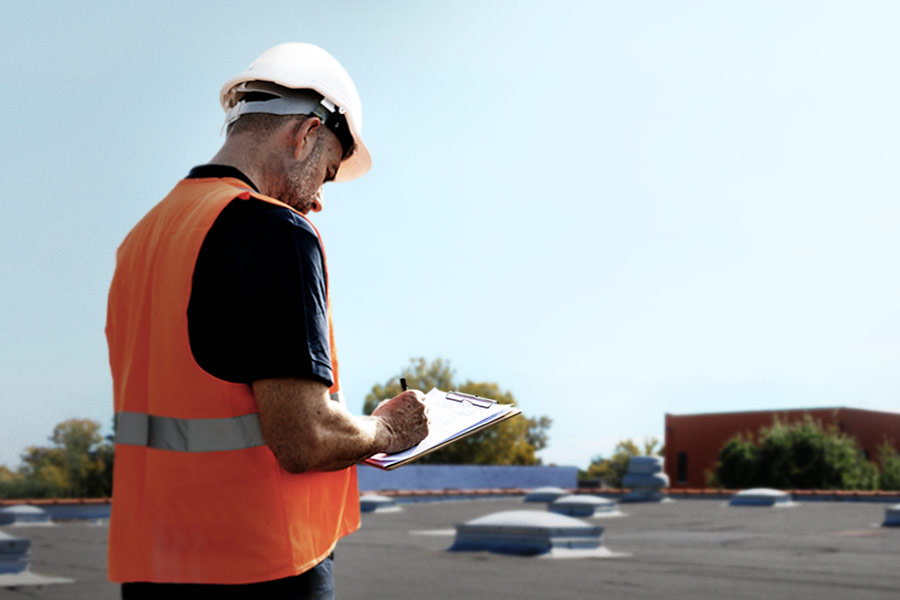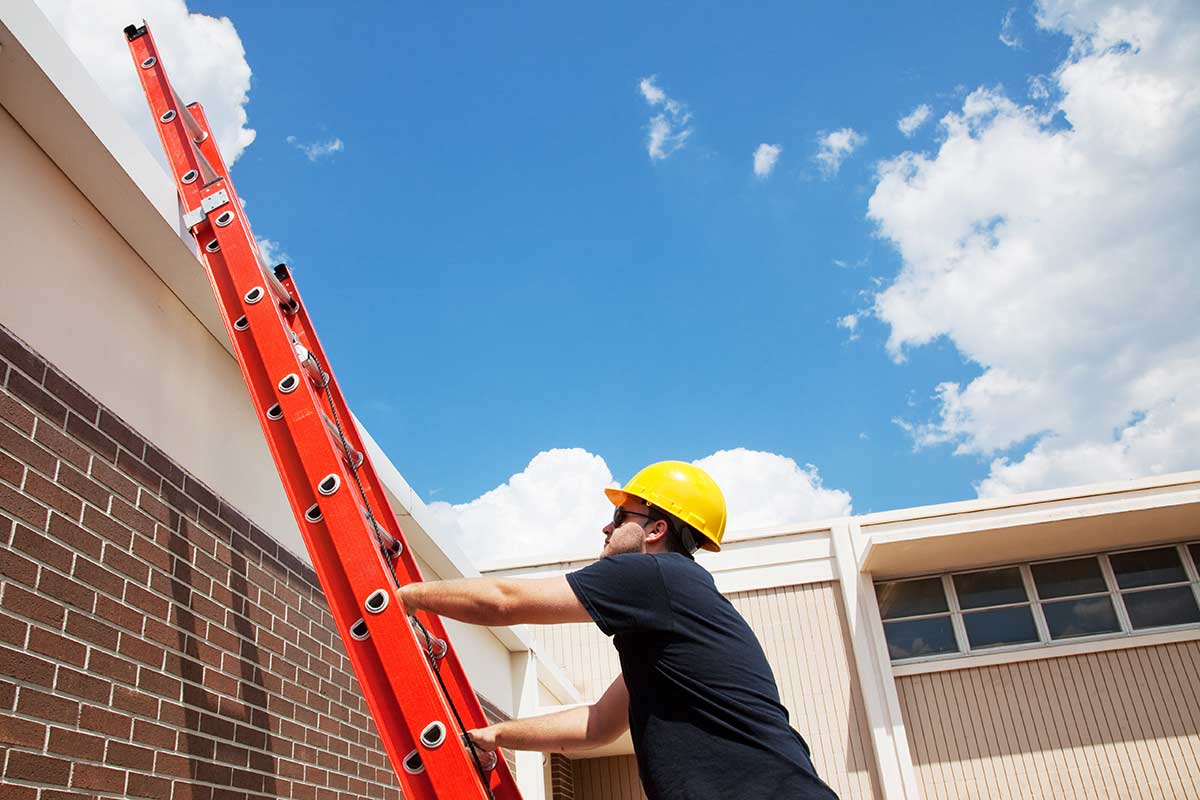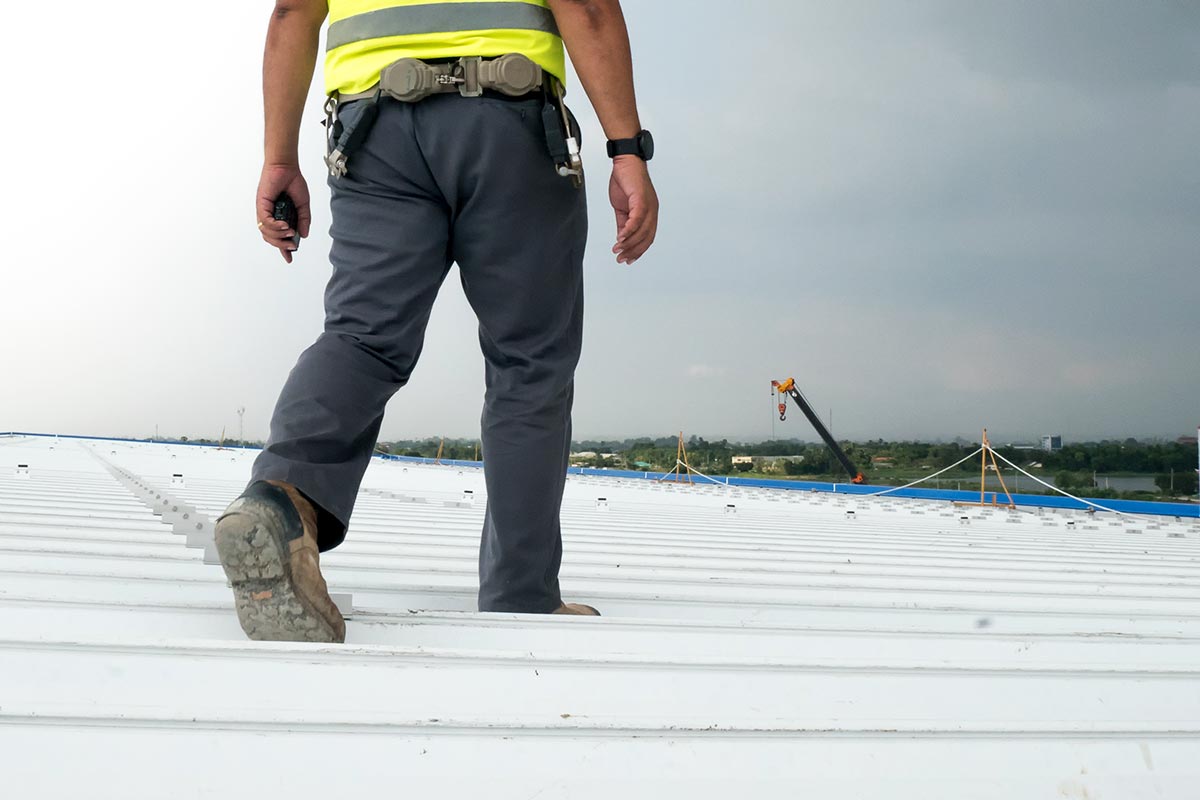
Perhaps you’ve noticed leaks in your building or unsightly brown stains on the ceilings and interior walls. Whatever the case may be, these seemingly trivial problems can have a negative impact on your business and will only get worse if left unaddressed.
If this describes your current situation, you might be left wondering: what’s my best course of action? Your first step is to contact your nearest commercial roofing contractor and have them conduct an inspection of your commercial roof.
Attention! If your commercial roof is in need of immediate repair, click here to schedule your free inspection with an American WeatherStar Approved Contractor.
Why Are Commercial Roof Inspections Important?
Did you know that 30% of your commercial building protects 100% of your assets? The roof makes up a third of your building—when you look at it from that perspective, your roof is an invaluable commodity that should be safeguarded at all costs.
That being said, most facility managers and property owners usually only think about their roofs when there’s a problem. While unfortunate, it’s certainly understandable. The roof isn’t something you typically see on a routine basis, if ever. Nonetheless, an “out of sight, out of mind” approach to commercial roof maintenance is never a good thing.
Commercial roofs are under constant attack from the elements. By addressing small problems now, you can avoid much bigger—and far more expensive—problems in the future. That’s why routine inspections are an integral part of any commercial roof maintenance program. They are a simple and cost-effective measure to maximize your roof’s performance and increase its life cycle.
While it is the job of the roofing contractor to know how to conduct a proper inspection, building owners should also know what to look for so they can make informed decisions related to their roofs.
How Often Should a Commercial Roof Be Inspected?
Commercial roofs, at minimum, should be inspected twice a year without fail! The ideal time of year to conduct a roof inspection is in the spring and fall. This ensures the roof will be prepared for the extreme weather and temperatures that usually accompany the summer and winter months.
It’s also not a bad idea to conduct follow-up inspections between the spring and fall seasons, especially if the roof has noticeable damage or after episodes of severe weather.
While it can be challenging to maintain the recommended biannual inspection regimen, committing to a routine maintenance plan for your commercial roof can significantly minimize recurring problems and help to ensure the long-term performance of your roofing system.
Common Problems Affecting Commercial Roofs
Considering all that commercial roofs have to endure, leaks and other problems are virtually unavoidable. In order to better understand what goes on during an inspection, let’s get a better idea of some of the more notable issues affecting both flat and metal commercial roof surfaces.
- Exposure to the sun, inclement weather, heavy winds, etc.
- Structural movement (aka thermal movement)
- Ponding water
- Rust/corrosion (specifically on metal roofs)
- Punctures, cracks, and tears (usually caused by severe weather, mechanical damage, or foot traffic)
- Debris, dirt, and other surface contaminants
- Biological growth
- Shrinkage
- Poor installation
- Neglecting maintenance
What’s Checked During a Commercial Roof Inspection?
Now that we’ve touched on some common problems affecting commercial roofs, let’s focus on the specific roofing components that need to be evaluated during an inspection. This process is more manageable with a multi-point roof inspection checklist. Roof inspection checklists are an essential part of any routine maintenance program and generally cover the following points:
Exterior Components
- Exterior walls
- Roof edge, fascia/coping
- Expansion joints
- Penetrations (chimneys, vents, skylights, exhaust fans, etc.)
- Drainage system (gutters, downspouts, scuppers, etc.)
- Field of roof (surface condition, rust/corrosion, ponding water, granule loss, etc.)
- Substrate firmness
- Base flashings
- Seams and fasteners
Interior Components
- Interior roof deck
- Ceilings
- Interior walls
Rooftop Equipment
- HVAC systems
- Communication equipment (satellite dishes, antennaes, etc.)
- Rooftop signage
- Solar panels
Click here to download our 40-Point Commercial Roof Inspection Checklist.
How Long Does the Inspection Process Take?
The amount of time needed to complete a commercial roof inspection mostly depends on the size of the roof. For an average size commercial roof (20,000 sq. ft.), the inspection process should only take about an hour. There are other factors to consider, however, such as roof type(s), number of penetrations/HVAC units, construction/design of the roof, accessibility issues, etc. Whatever the case may be, it’s crucial that each and every component of a commercial roof be inspected thoroughly.
Additional Roof Inspection Methods
In addition to the “visual” inspection points outlined above, there are other methods that can be used to supplement the inspection process. These methods aren’t necessarily required during a commercial roof inspection, but they do help to paint a clearer picture of the overall roofing environment.
Core Samples
A core sample involves extracting small portions of the roof with a core cutting tool. This essentially provides a snapshot of the entire roofing assembly by helping to determine the number of layers, substrate material, and condition of the insulation. In situations where the roof deck cannot be seen from inside the building, a core sample can also help determine the type of decking material (e.g., metal, wood, or concrete).
The number of core samples collected during an inspection mainly depends on the size of the roof and the extent of saturated insulation. If there’s no evidence to suggest that moisture is an issue, taking a core sample may not be necessary, though it is recommended as a precaution.
Video: Click here to watch a core sample being taken out of a modified bitumen roof.
Infrared Moisture Scans
In many cases, an infrared moisture scan may be conducted during an inspection to detect any moisture in the roofing assembly that may not be visible to the naked eye. Specifically, an infrared camera is used to inspect the insulation and underlying layers of the roof that could potentially be saturated from leaks.
Most infrared scans are done at night as the roof surface begins to cool down. This helps the camera better detect temperature variations between saturated and unsaturated areas of the roof (pictured above). The images produced help contractors identify areas of saturated insulation that need to be replaced.
Other moisture detection equipment, such as hand-held moisture meters or deck scanners, can also be used to more accurately identify areas of saturation within a roofing assembly.
Drone Inspections
Camera drones can play a very useful role in the commercial roof inspection process. They are commonly used in conjunction with infrared cameras to gain a much broader view of a roof’s thermal signature. Drones can also be used to evaluate a roof’s general appearance or to safely access hard-to-reach areas.
Once the Inspection Is Done, What’s Next?
Once all the information is gathered, the contractor will put together an inspection report which includes pictures and descriptions of any issues found within your roofing system. The report will also lay out what options are available to properly fix your roof as well as a quote for the proposed work.
Depending on their findings, you may be presented with any number of the three options below:
Repair/Patch: From a cost standpoint, a repair or patch is a best-case scenario on most commercial roofs and is only recommended if the roofing assembly is in good condition. For flat roofs, saturation needs to be virtually nonexistent. For metal roofs, leaks need to be confined to a relatively small area (or number of areas). Otherwise, the need for roof repairs is going to be a frequent and costly occurrence.
Restore: As long as leaks and saturation issues aren’t too widespread, roof restoration is likely the best alternative. Unlike a repair or patch, restoration typically addresses the entire roofing assembly and can greatly reduce the need for constant maintenance and repair. Roof restoration does cost more than traditional repair methods, but it also offers many of the same advantages of a brand new roof.
Replace: If leaks and saturated insulation are rampant throughout the roofing system, a total replacement is going to be the most cost-effective means for restoring your commercial roof’s performance.
As stated before, the goal of this post was to help building owners and property owners make a well-informed decision after a contractor has conducted an inspection on their roof. Though the contractor’s job is to determine the solution for your roof, it never hurts to do your homework.
Once you have the report in hand, it’s time to review it and determine the best course of action. In the end, it’s about finding the most appropriate and cost-effective solution to suit your roof’s needs.
We’re Here To Help!
At American WeatherStar, we partner with commercial roofing contractors from across the nation to provide high-quality fluid-applied roof restoration systems. If your building’s roof is experiencing any of the issues mentioned above, we encourage you to schedule a free commercial roof inspection with one of our Approved Contractors in your area. They will help you determine the best possible solution for your roof and will provide you a free quote for the project as well.
Related Posts
Roof Restoration: The Comprehensive Guide
Over the years, roof restoration has become an increasingly popular alternative to roof replacement. Although, it’s still a relative unknown to…
How to Establish a Roof Maintenance Program
The most important reason for establishing a roof maintenance program is to protect the capital investment of a new roof. Proper maintenance…
5 Commercial Roof Maintenance Best Practices
Having a solid plan for commercial roof maintenance and repairs is critical to keeping your roof strong and preventing premature roof failure.…













